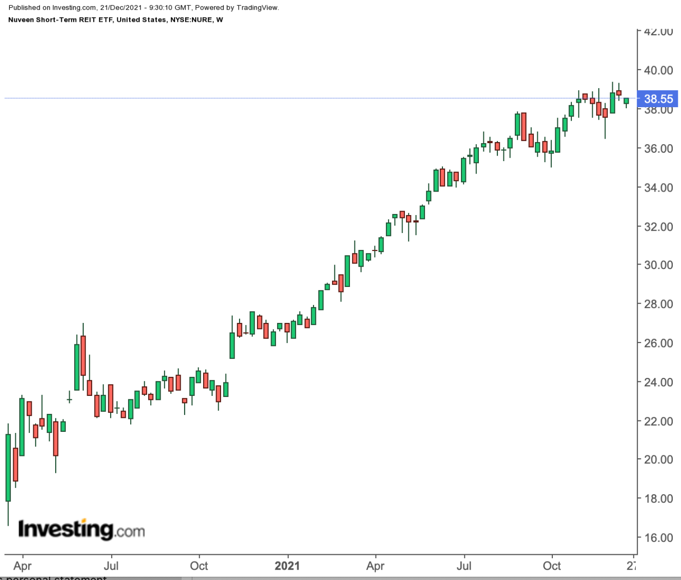Real estate investment trusts (REITs) enable maket participants to invest in the growth of real estate, one of the most important segments of any economy. The asset class typically provides passive income from dividends as well as capital appreciation. Over the past 52 weeks, the Dow Jones Real Estate index is up over 31%.
Meanwhile, the National Association of Home Builders' Housing Market Index (HMI), released Dec. 15, showed robust builder confidence. The metric takes the pulse of the US single-family housing market. Wall Street has been debating the potential effect of inflationary pressures as well as various production bottlenecks, including labor and materials.
The National Association of Real Estate Investment Trusts (Nareit) highlights:
“Long term leases typically have inflation protection built-in, and shorter-term leases are based on current price levels. Also, REITs keep a portfolio of leases, a portion of which are negotiated every year, so even REITs with longer-term leases have opportunities to reprice. Finally, as owners of real assets, REITs typically enjoy an appreciation in portfolio value along with the price level.”
In previous articles, we covered several exchange-traded funds (ETFs) that focus mainly on real estate stateside, including:
- JP Morgan BetaBuilders MSCI US REIT (NYSE:BBRE)—up 33.1% YTD,
- iShares Residential and Multisector Real Estate ETF (NYSE:REZ)—up 37.1% YTD,
- The Real Estate Select Sector SPDR Fund (NYSE:XLRE)—up 34.3% YTD,
- Vanguard Real Estate Index Fund ETF Shares (NYSE:VNQ)—up 30.0% YTD.
Today, we extend the discussion to two other funds that could appeal to a range of readers.
1. Fidelity MSCI Real Estate Index ETF
- Current Price: $32.88
- 52-Week Range: $24.30 - $33.68
- Dividend Yield: 3.44%
- Expense Ratio: 0.08% per year
Our first fund, the Fidelity® MSCI Real Estate Index ETF (NYSE:FREL) gives access to the US real estate sector. The fund started trading in February 2015.
FREL, which has 167 holdings, tracks the returns of the MSCI USA IMI Real Estate Index. Its top 10 holding account for around 40% of net assets of $2.1 billion.
Among the top names on the roster are American Tower (NYSE:AMT), Public Storage (NYSE:PSA), Prologis (NYSE:PLD), Crown Castle (NYSE:CCI), Equinix (NASDAQ:EQIX) and Simon Property Group (NYSE:SPG).
Since the start of the year, the ETF is up 28.8%, and hit an all-time high in recent days. Trailing P/E and P/B ratios are 35.05x and 3.05x.
Despite the recent run-up in price, US real estate is likely to still have legs. We also like the diversity of FREL. However, a potential decline toward the $32 level or even below would improve the margin of safety. Long-term shareholders are also entitled to dividends of about 3.4%.
2. Nuveen Short-Term REIT ETF
- Current Price: $38.55
- 52-Week Range: $25.83 - $39.83
- Dividend Yield: 2.06%
- Expense Ratio: 0.35% per year
The Nuveen Short-Term REIT ETF (NYSE:NURE) provides exposure to US REITs with short-term lease agreements. Fed watchers expect policy makers to start raising interest rates soon. Therefore, REITs with short-term leases might be affected less by interest rate increases.
NURE, which has 36 holdings, tracks the returns of Dow Jones US Select Short-Term REIT Index. The fund started trading in December 2016, and has around $106.4 million in assets.
In terms of the sub-sectoral breakdown, the apartment REITs sector makes up the highest portion with 50.57%. Then come self-storage REITs (20.68%) and hotel REITs (19.22%). The fund’s top 10 names account for over half of the fund.
Leading REITs include Mid-America Apartment Communities (NYSE:MAA), Camden Property Trust (NYSE:CPT), Essex Property Trust (NYSE:ESS), Extra Space Storage (NYSE:EXR), Public Storage (NYSE:PSA), and CubeSmart (NYSE:CUBE).
Year-to-date, the ETF is up 42.3%, and, like FREL, saw a record high in December. Given the short lease terms of the REITs, they would be better able to ask for more frequent rent hikes from tenants.
However, because of the lofty returns so far in the year, short-term profit-taking could be in the cards. Interested readers could regard the $36.5 level as a better entry point. Finally, the current price supports a dividend yield of around 2%.
